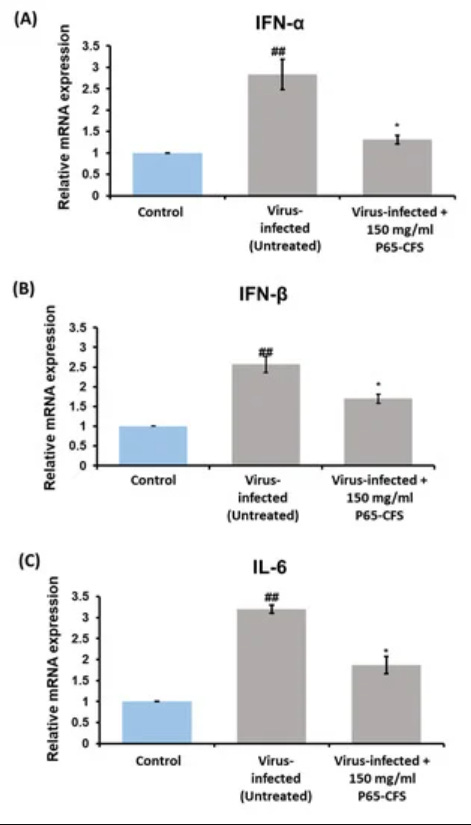Friday Hope: Kimchi: A Potential Adjuvant Therapy to Prevent Severe COVID and Shorten Illness
Lactobacillus sakei Probio65, Isolated from Kimchi, is the Powerful, Therapeutic Wonder Bacteria
Modulation of the expression of inflammatory markers in HEK 293 cells after infection in the presence and absence of L. sakei Probio65 cell-free supernatant (P65-CFS). The expression of (A) IFN-α, (B) IFN-β, and (C) IL-6 were measured using quantitative PCR and normalized to GAPDH. All the experiments were conducted in triplicate and statistical analysis were performed using the t-test. Analysis of each sample was performed in triplicate, and data are represented as the means ± SD of three independent experiments. * p < 0.05 compared with virus-infected cells; ## p < 0.05 compared with the control.
Given the recent findings that the gut microbiome is a great modulator of COVID infection and severity, I thought it would be helpful to find natural therapeutics which could not only improve our own gut microbiomes, but also work as an adjuvant treatment for COVID. I found one natural food that accomplishes both tasks: Kimchi.
Kimchi (/ˈkɪmtʃiː/; Korean: 김치, romanized: gimchi, IPA: [kim.tɕʰi]), is a traditional Korean side dish of salted and fermented vegetables, such as napa cabbage and Korean radish. A wide selection of seasonings are used, including gochugaru (Korean chili powder), spring onions, garlic, ginger, and jeotgal (salted seafood), etc. Kimchi is also used in a variety of soups and stews. As a staple food in Korean cuisine, it is eaten as a side dish with almost every Korean meal.
It is during the fermentation process of this superfood that the real magic happens.
The microorganisms present in kimchi include Bacillus mycoides, B. pseudomycoides, B. subtilis, Lactobacillus brevis, Lb. curvatus, Lb. kimchii, Lb. parabrevis, Lb. pentosus, Lb. plantarum, Lb. sakei, Lb. spicheri, Lactococcus carnosum, Lc. gelidum, Lc. lactis, Leuconostoc carnosum, Ln. citreum, Ln. gasicomitatum, Ln. gelidum, Ln. holzapfelii, Ln. inhae, Ln. kimchii, Ln. lactis, Ln. mesenteroides, Serratia marcescens, Weissella cibaria, W. confusa, W. kandleri, W. kimchii. W. koreensis, and W. soli. Archaea and yeasts, such as Saccharomyces, Candida, Pichia, and Kluyveromyces are also present in kimchi, with the latter being responsible for undesirable white colonies that sometimes form in the product as well as food spoilages and off-flavors.
In early fermentation stages, the Leuconostoc variety is found more dominantly in kimchi fermentation because of its lower acid tolerance and microaerophilic properties; the Leuconostoc variety also grows better at low salt concentrations. Throughout the fermentation process, as acidity rises, the Lactobacillus and Weissella variety become dominant because of their higher acid tolerance. Lactobacillus also grows better in conditions with a higher salt concentration.
Kimchi
https://en.wikipedia.org/wiki/Kimchi
There is no doubt that the microorganisms which develop in Kimchi are beneficial to overall gut health. However, one in particular, Lb. sakei is the bacteria that has been proven to be beneficial in the fight against COVID.
A paper published in December of last year explored the benefits of Lb. sakei as a treatment for COVID, with promising results.
Remarkably, the reduction of cytokine expression from treatment with Lb. sakei was beyond impressive.
Cytokine activation is one of the most prominent features of a cellular viral infection, as it is a means by which the cells stimulate downstream antiviral signaling pathways to counteract the virus [19]. In this study, the gene expression levels of cytokines IFN-α, IFN-ß, and IL-6 were determined after the cells were infected with SARS-CoV-2. The results showed that the cells expressed a 2.83-, 2.6-, and 3.2-fold increase in IFN-α, IFN-ß, and IL-6, respectively, as compared to the healthy cells (p < 0.05). The treatment of P65-CFS at 150 mg/mL reduced the expression of IFN-α by 53.76%, IL-6 by 40.6%, and IFN-ß by 34.6%, as compared to the infected cells (p < 0.05).
This is evidence that Lb. sakei is instrumental in reducing the severity of COVID.
Furthermore, Lb. sakei also significantly inhibits SARS-CoV-2 replication and the generation of ROS, which may prevent the damage being observed to mitochondria and transcription errors.
In this study, we observed that treatment using the extract of L. sakei Probio65, at a concentration that was not cytotoxic to the HEK 293 cells, significantly reduced SARS-CoV-2 replication by up to about 60%. Our results showed that this reduction in virus replication is accompanied by a concomitant reduction in ROS production.
The Inhibition of SARS-CoV-2 and the Modulation of Inflammatory Responses by the Extract of Lactobacillus sakei Probio65
https://www.mdpi.com/2076-393X/10/12/2106
We should continue to study Kimchi and its apparent beneficial effects for treating COVID, and the effects of its Spike Protein.
Besides, I find Kimchi to be absolutely delicious. I hope you do, too. If you haven’t tried it yet, you have every reason to do so now.
Bon Appetit!




Raw and fermented foods are the key to a healthy microbiome. Try sour kraut as well.
Very interesting Walter. If you look at South Korea through the Worldometer data, they didn't experience a significant rise in cases or deaths until late 2021/early 2022. As the highest Kimchi consuming country, one interpretation of this would be that they were well protected from the "pandemic", at least until their somewhat lagging in time mRNA vax campaign caught up and crippled their collective immune systems.
https://www.worldometers.info/coronavirus/country/south-korea/